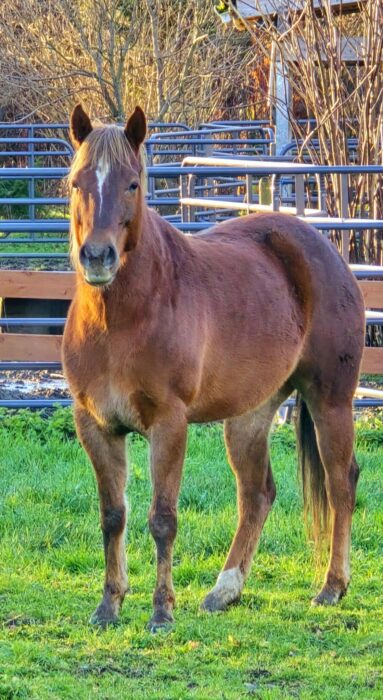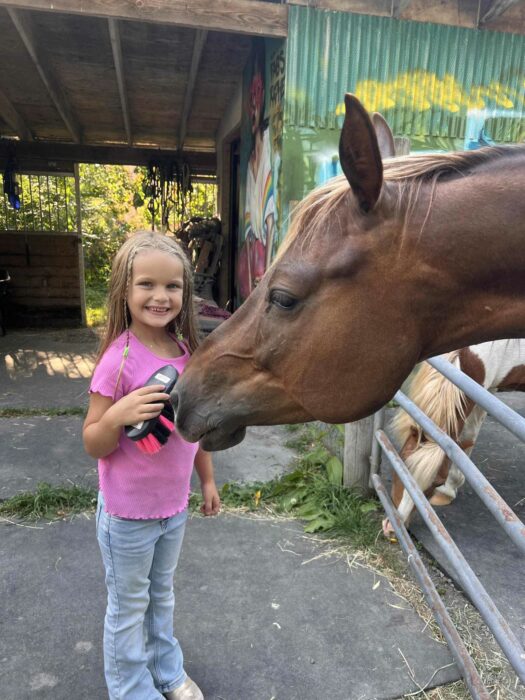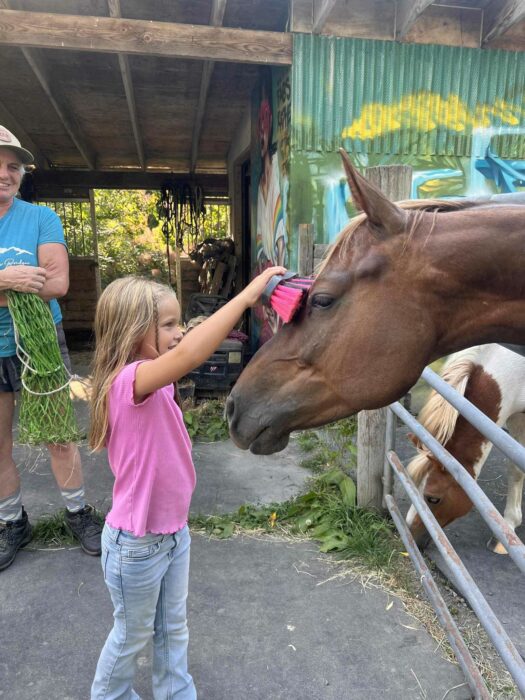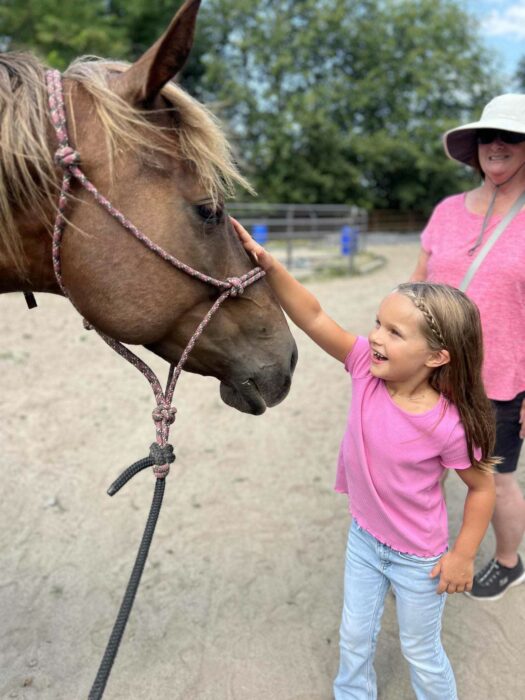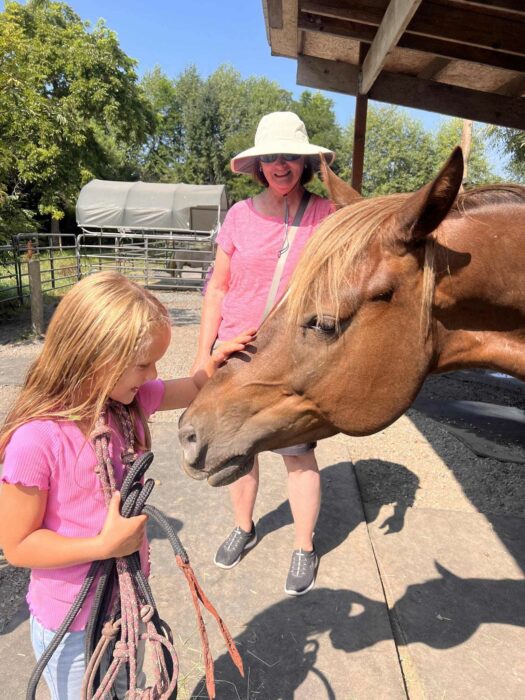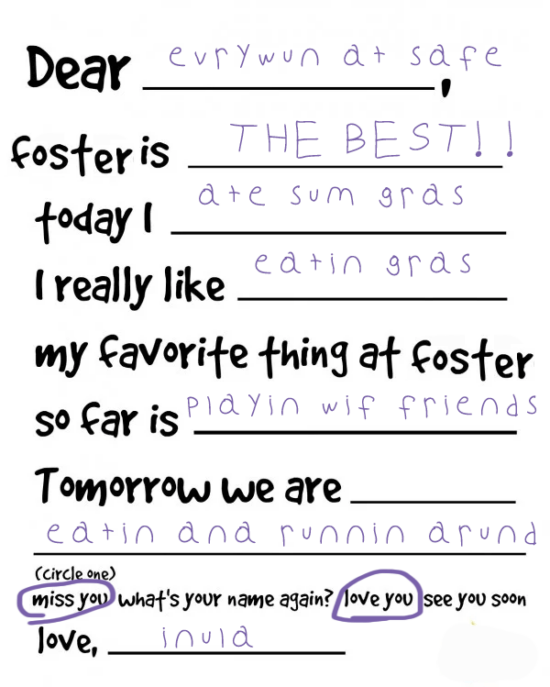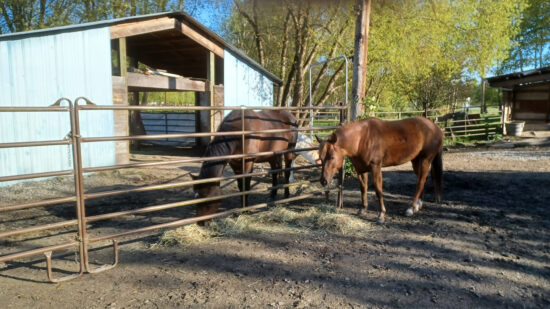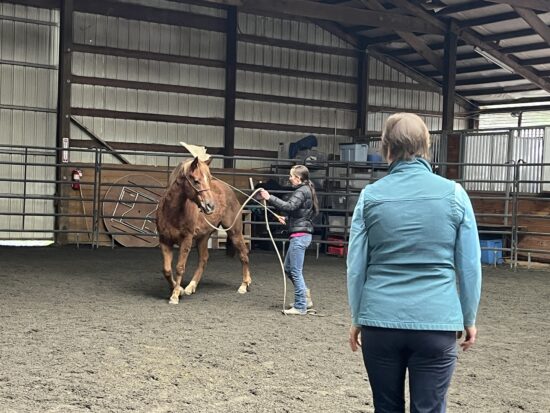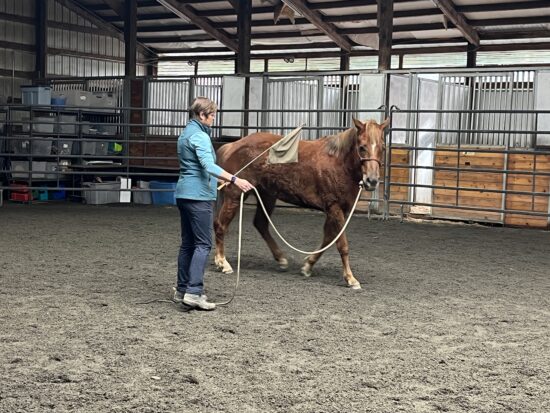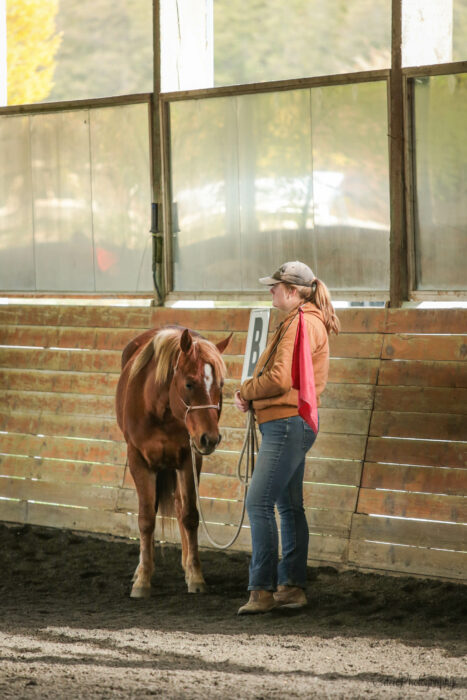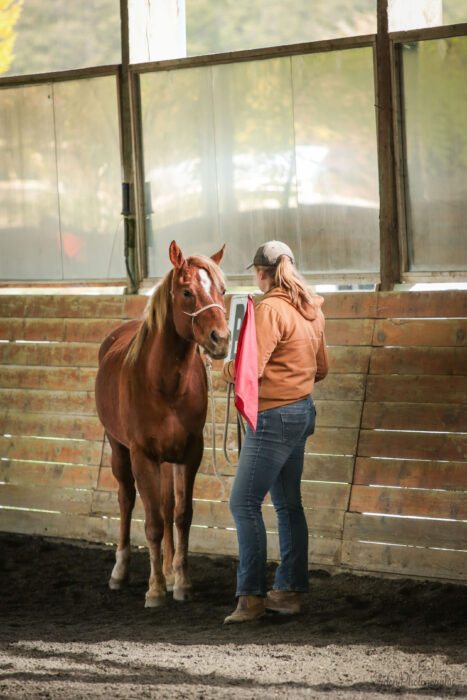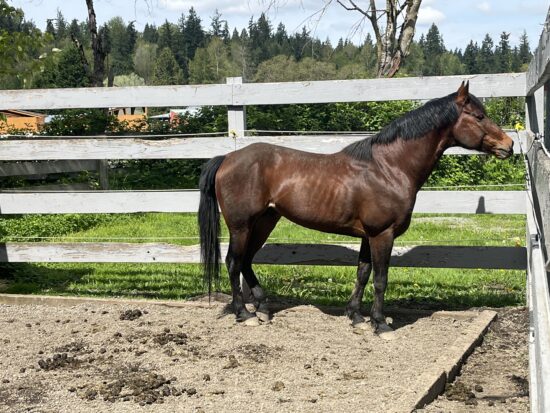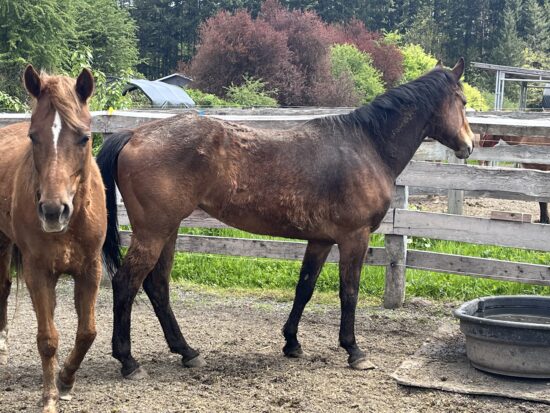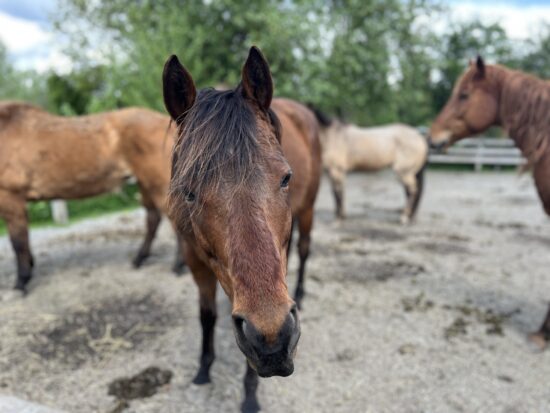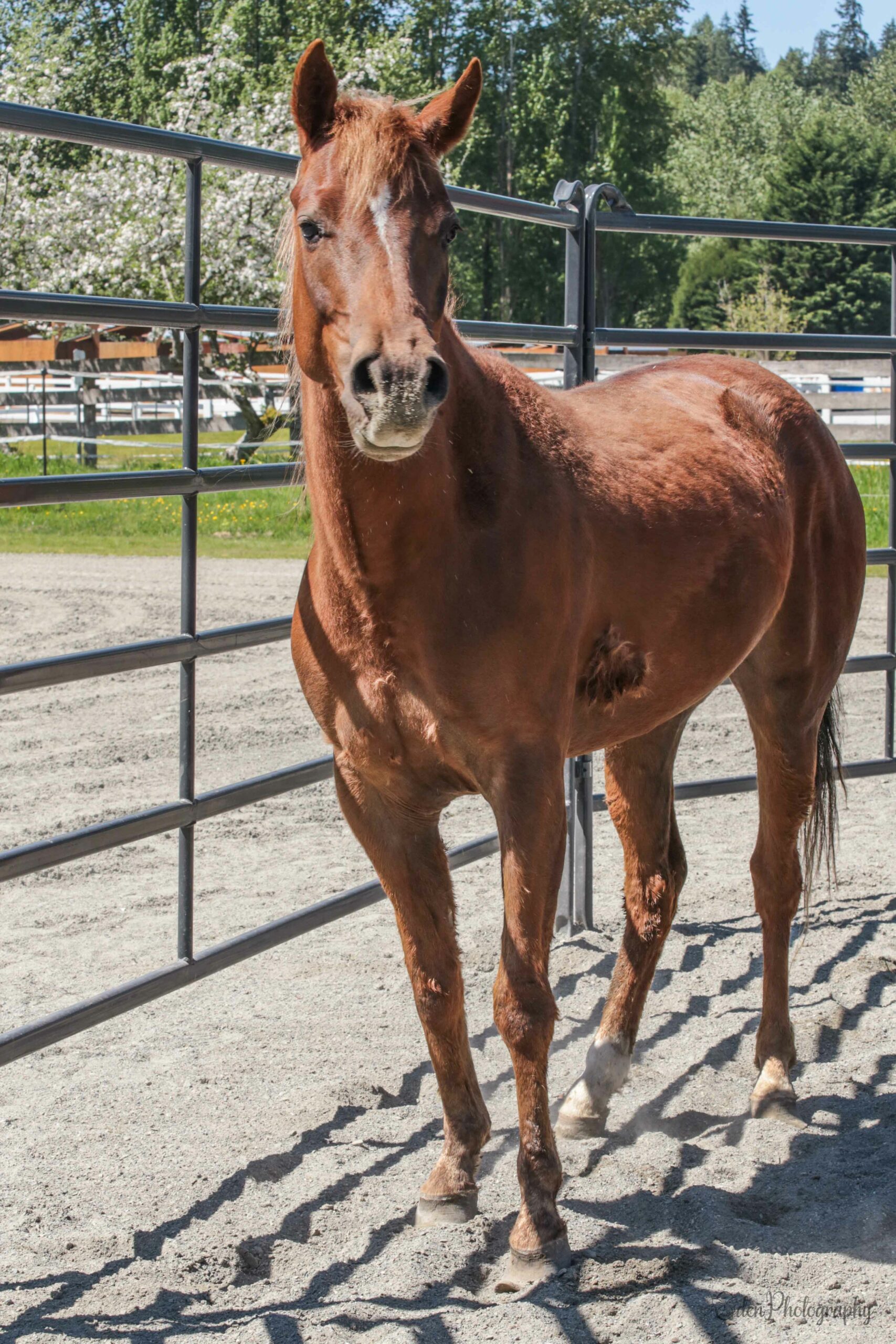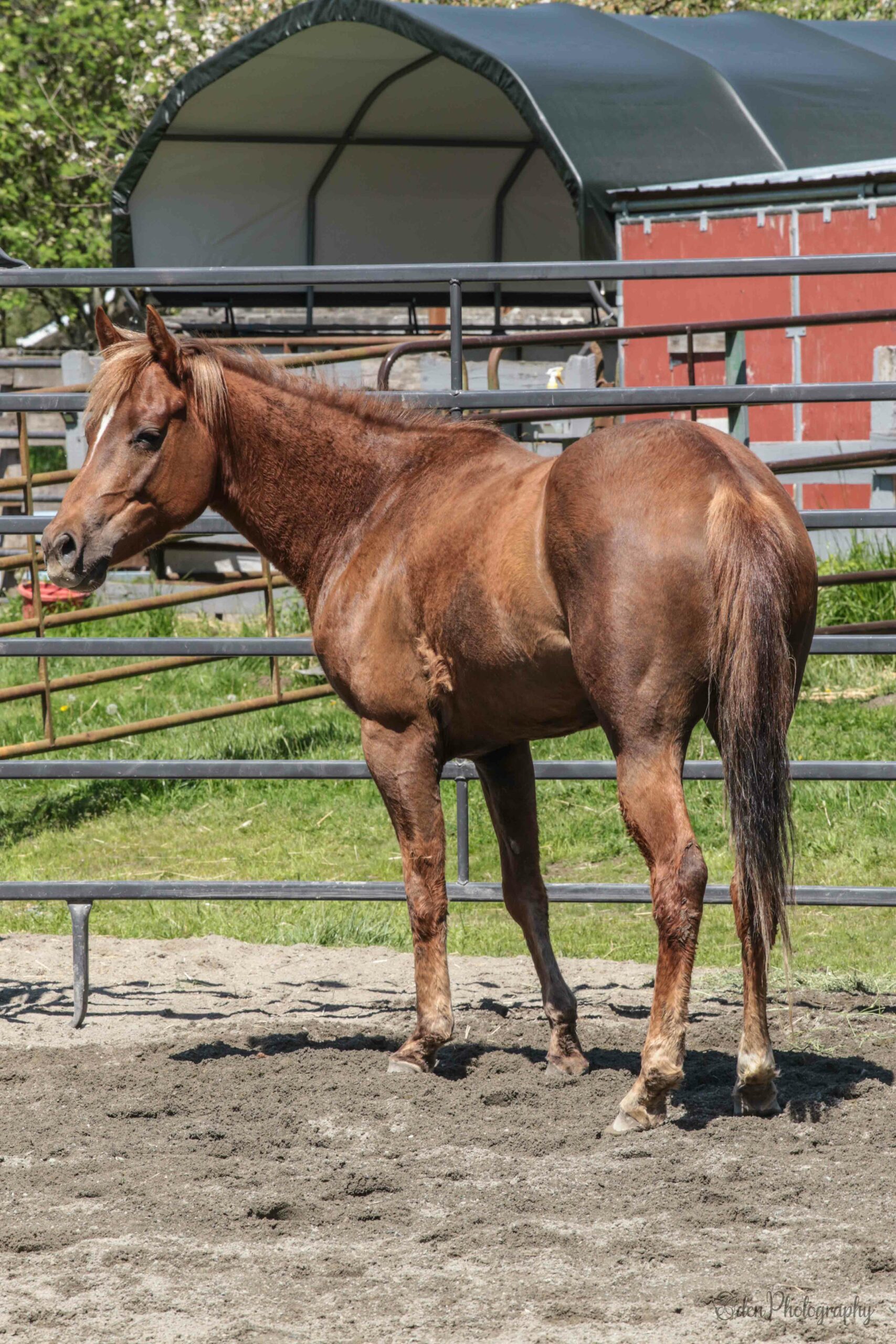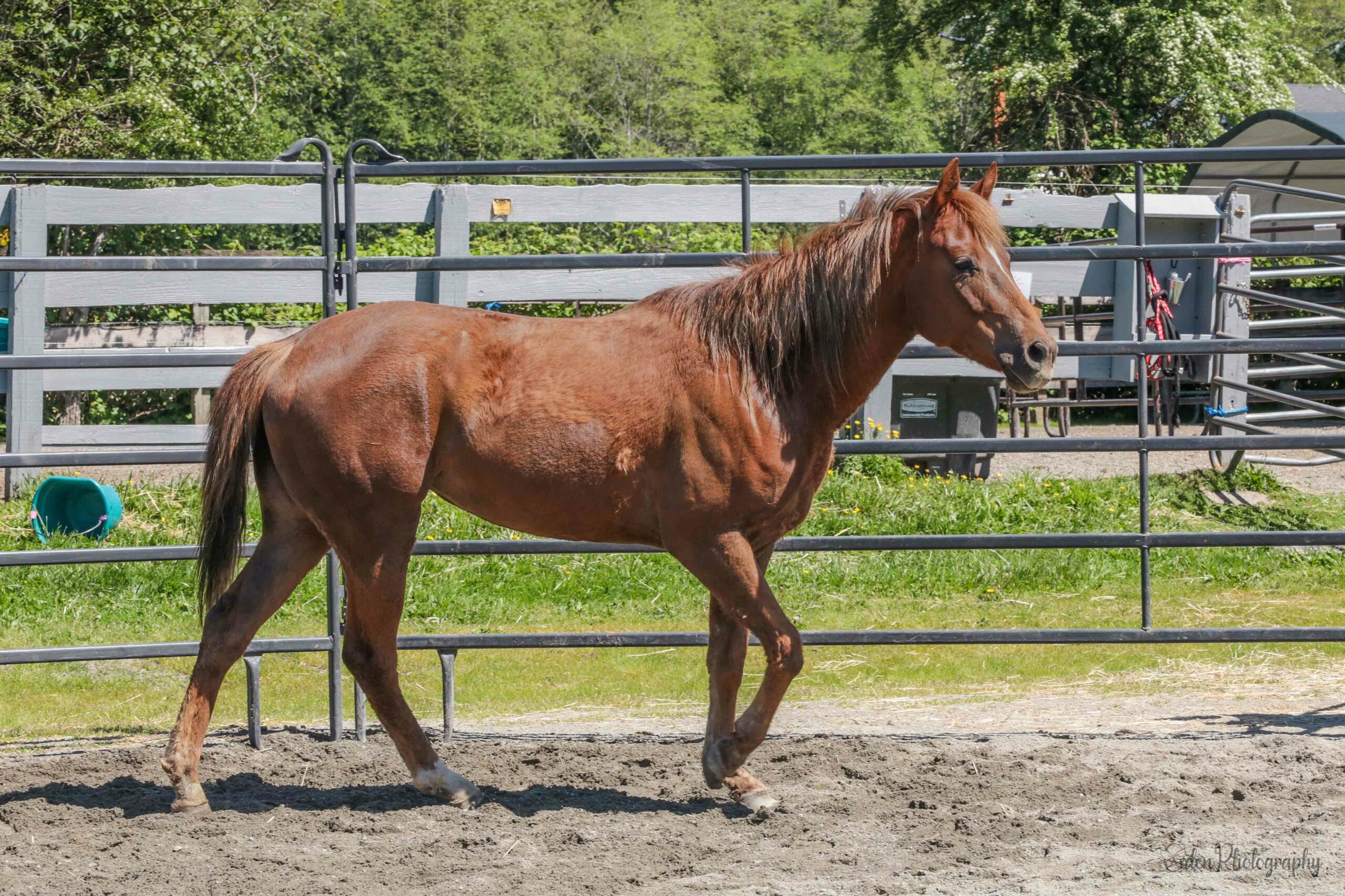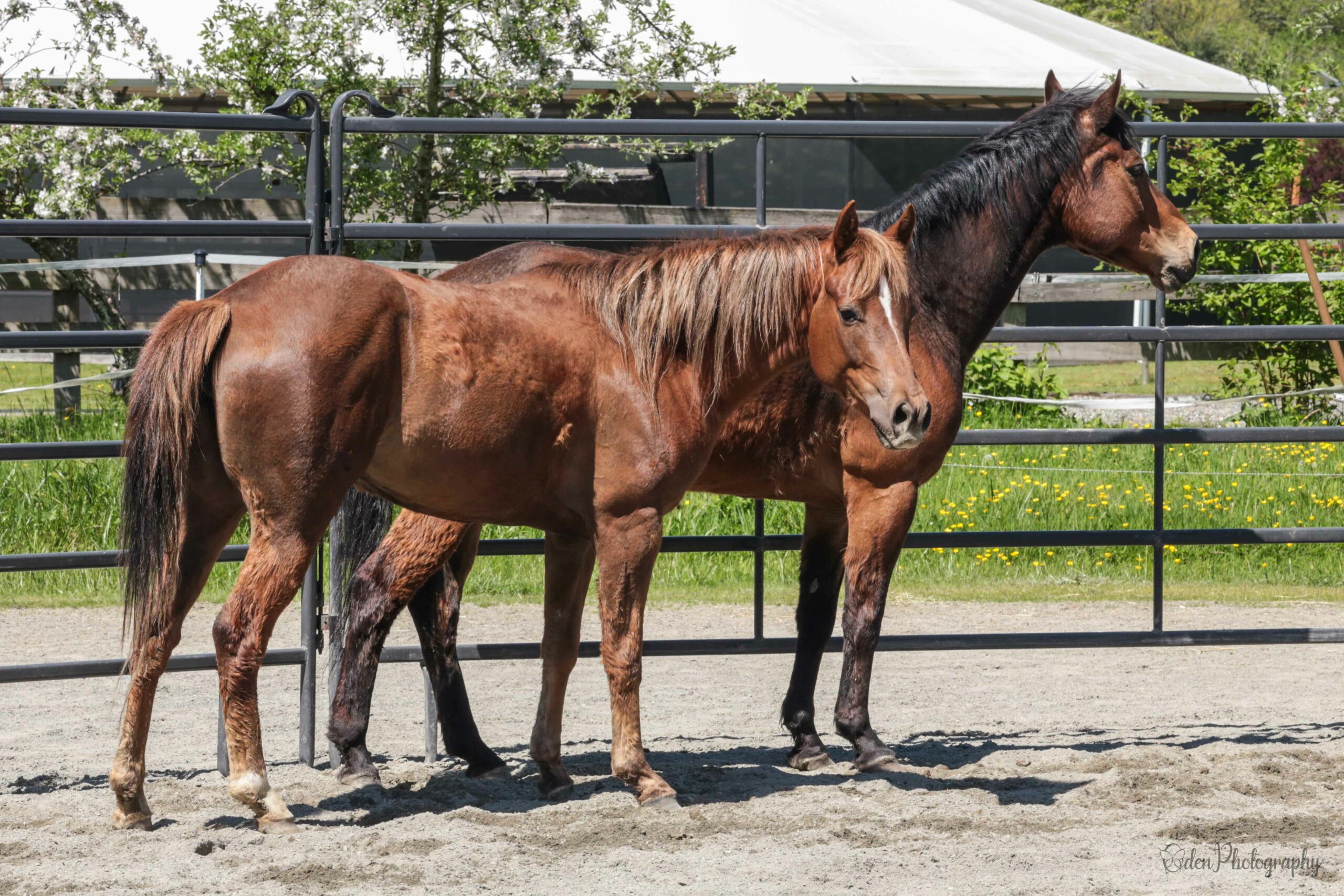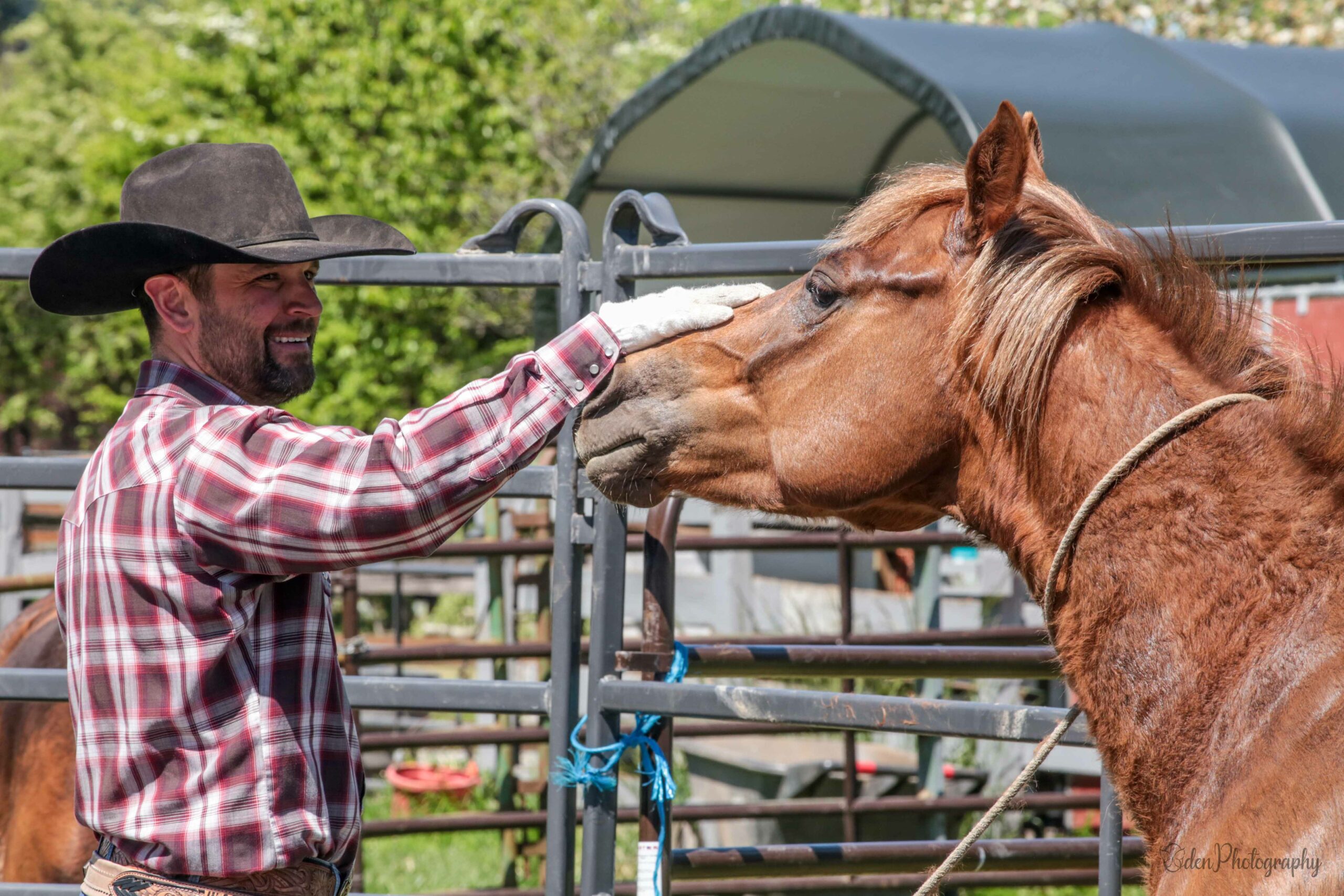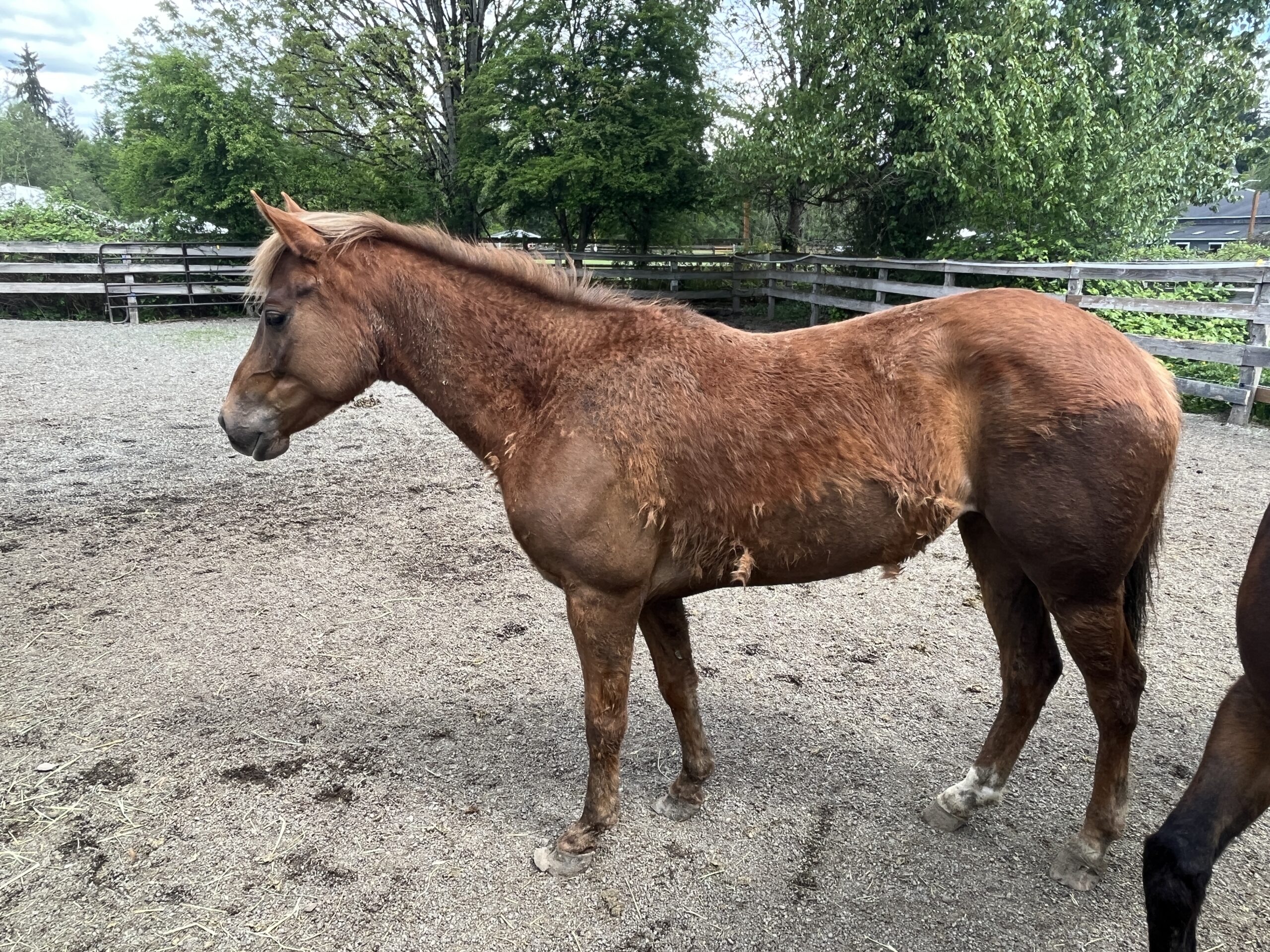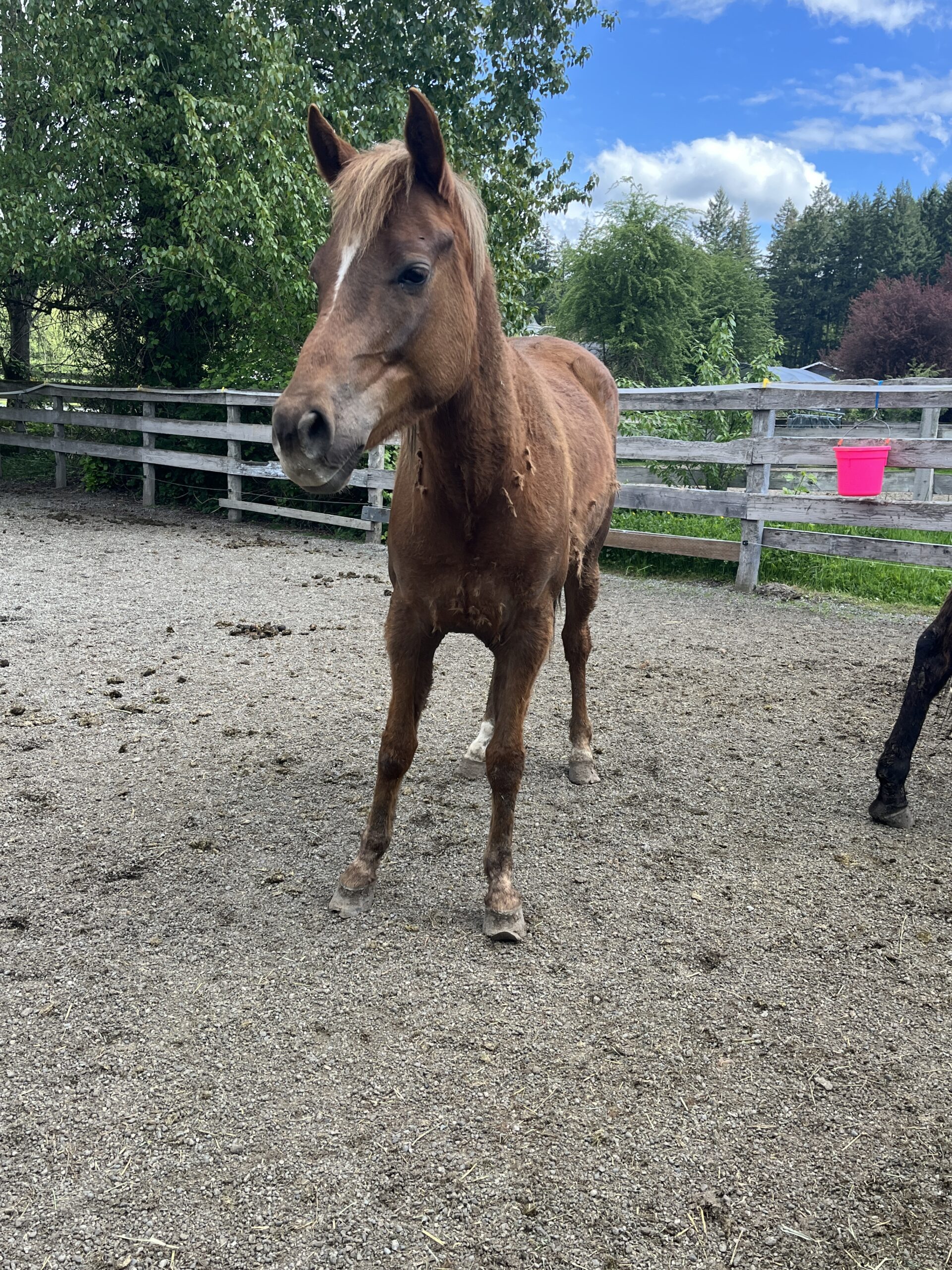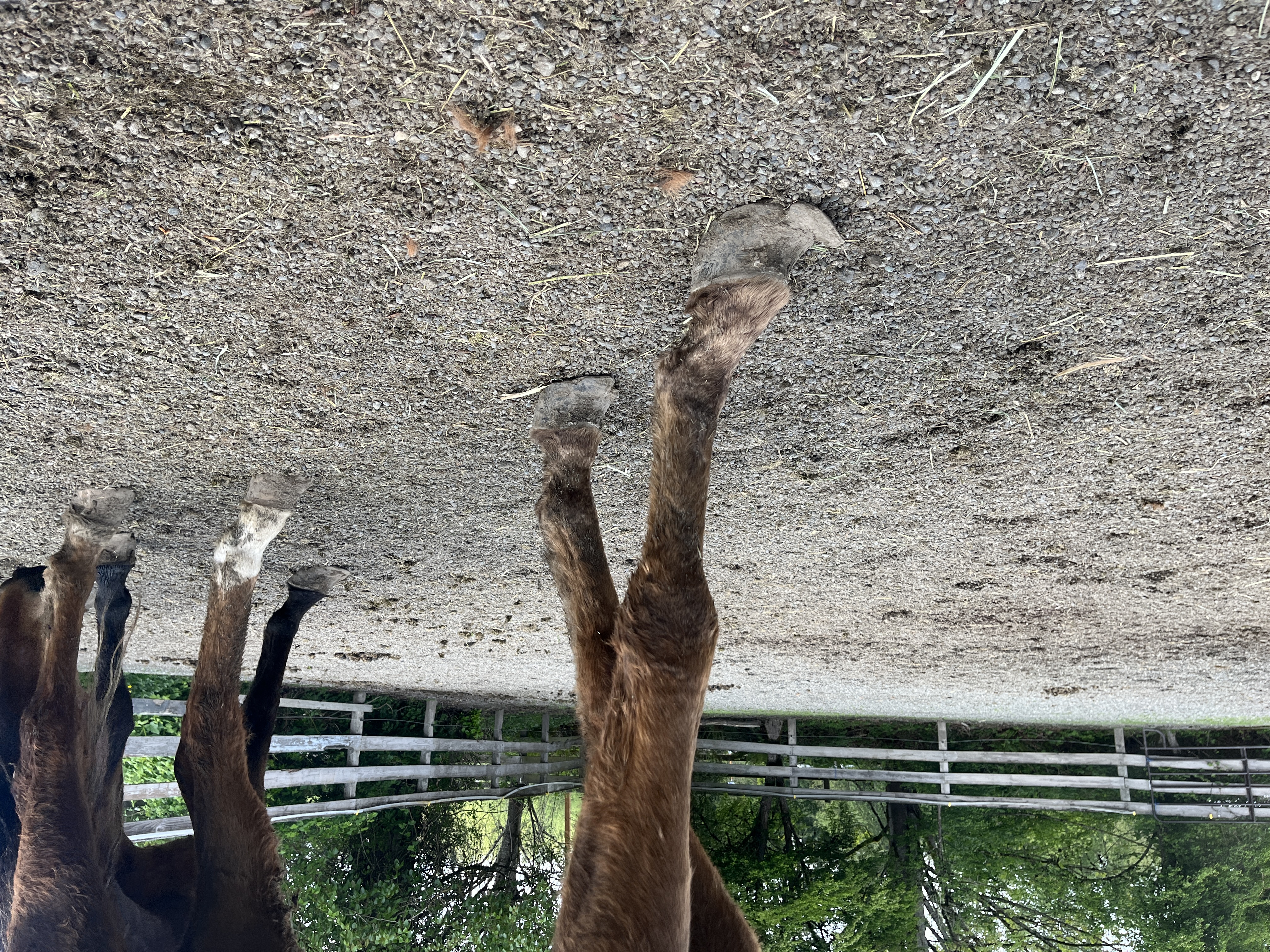Inula
2019 Quarter Horse Mare
Suitability: Companion, For Intermediate Handler
Color: chestnut
Markings: thin blaze
Height: 13.3h
Weight: 724lbs
Adoption Fee: $500
Inula came to SAFE in May of 2023 as part of a 7‑horse owner surrender situation in the Gig Harbor area. She, along with her 6 herd mates, were living in poor conditions, surrounded by broken panels, standing in deep mud, without clean water.
Inula is the youngest of the group, only around 4 years old. This little mare is curious and sweet, with a ton of try and willingness to learn. She is a fast learner, and a horse who does not have many negative experiences to draw on, leaving her a relatively blank canvas.
Inula was diagnosed with ringbone, which meant that our plans to saddle and ride her were pushed to the side in favor of her health. But she will make a lovely little companion for some lucky horse (and human!).
All SAFE horses are adopted with a no-breeding clause, no exceptions.
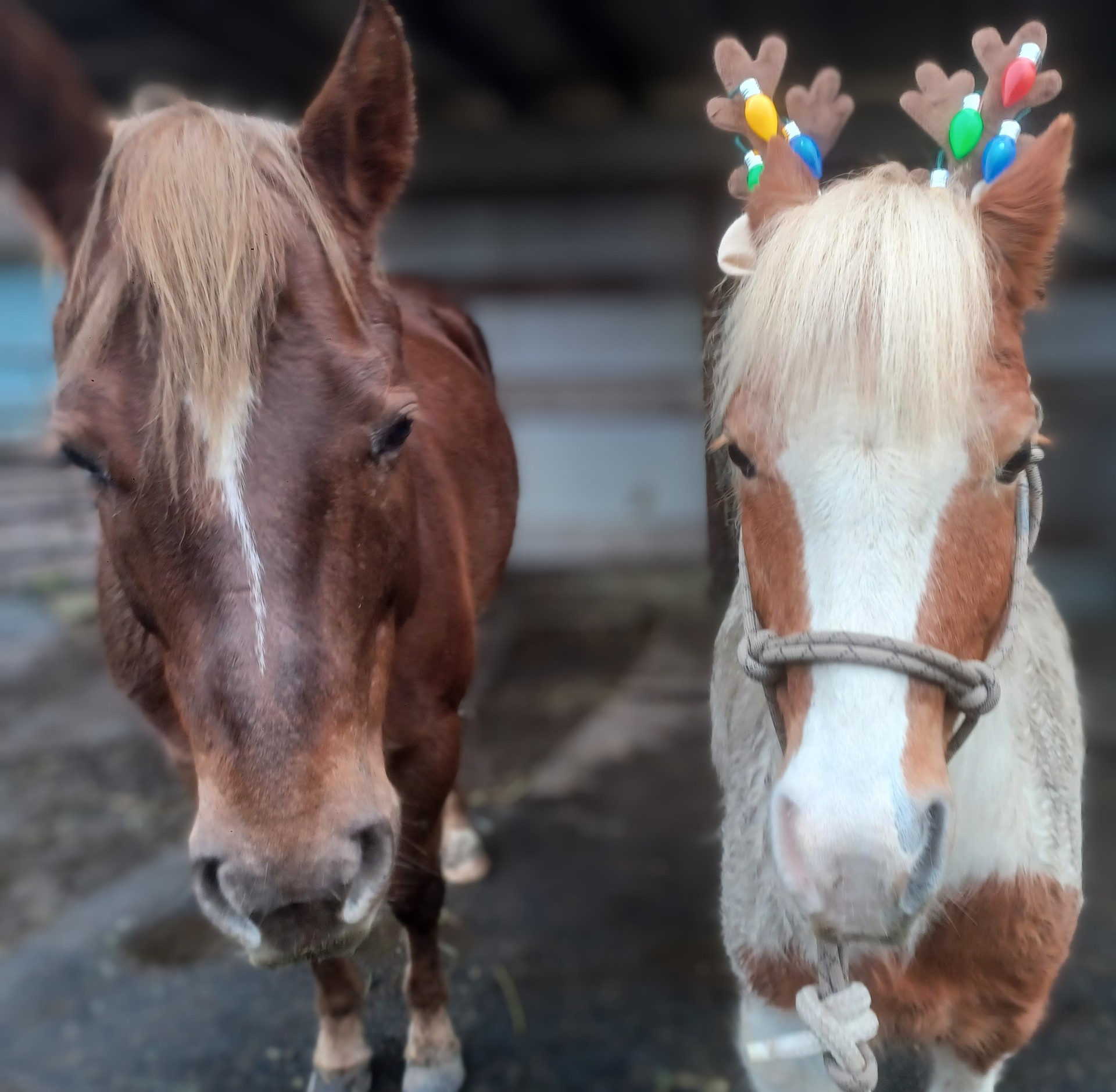
Inula’s Sunny Days
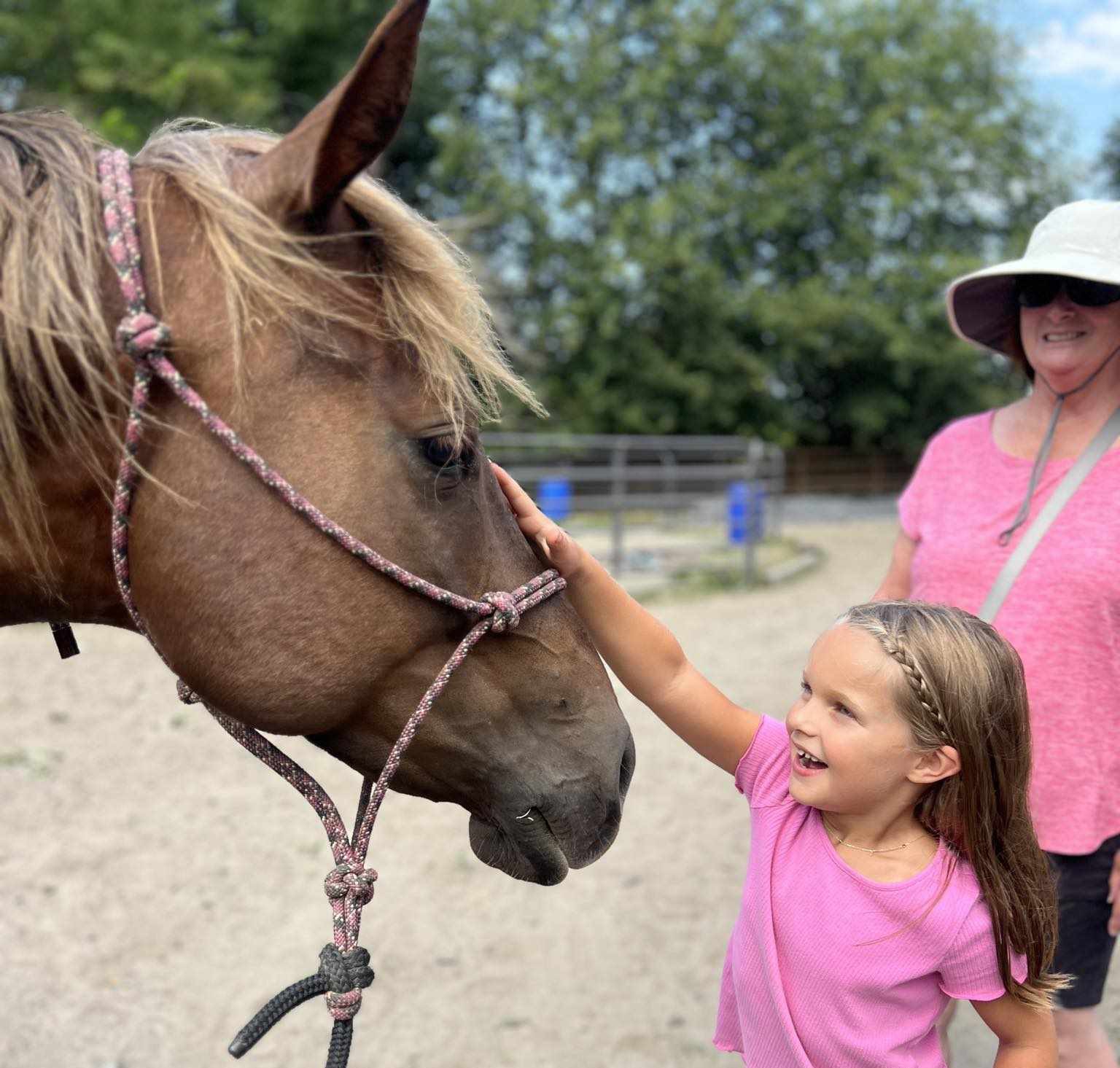
Inula’s New Friend
It’s a common expression that horse’s are a girl’s best friend, but some horses are certainly more inherently suited to the role than others. Inula is one such horse, whose natural sweetness propels her into instant BFF status. This cutie has been hanging out at foster with some four-legged friends, but recently had some visitors of the two-legged variety — including one close to Inula’s own age. These two have quite a bit in common, both being young ladies, and they really hit it off. Inula is a curious mare, and was very keen on checking out her visitor thoroughly, who didn’t seem to mind one bit the little mare’s inquisitive sniffs.
Inula would make a wonderful companion to both horse and human of all shapes and sizes, as she has proven time and again during her time at foster. We are hoping that a forever home arises sooner than later for this mare!
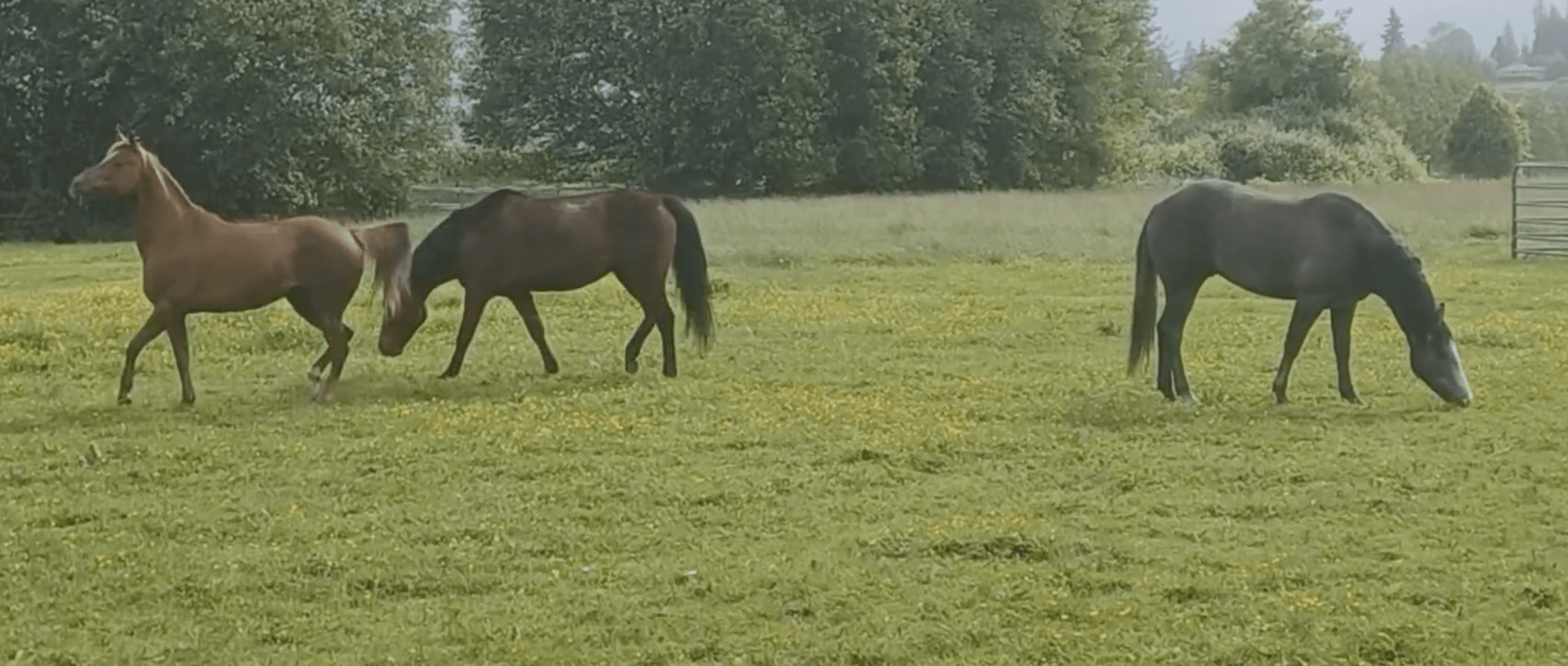
Inula at Summer Camp!
Inula is doing great at foster, and settling in well with the rest of the herd! She had already been introduced to SAFE Alumni Finn (formerly Doolin), but this past week met foster mom Shannon’s horse-sized horses as well. Introductions went well, and the four of them enjoy grazing and play time during the day while remaining separated at night to avoid any potential shenanigans. Inula is very busy with her daily schedule of eating, running around, and napping, but took a little bit of time out of her day to write us this letter and let us know she’s doing well.
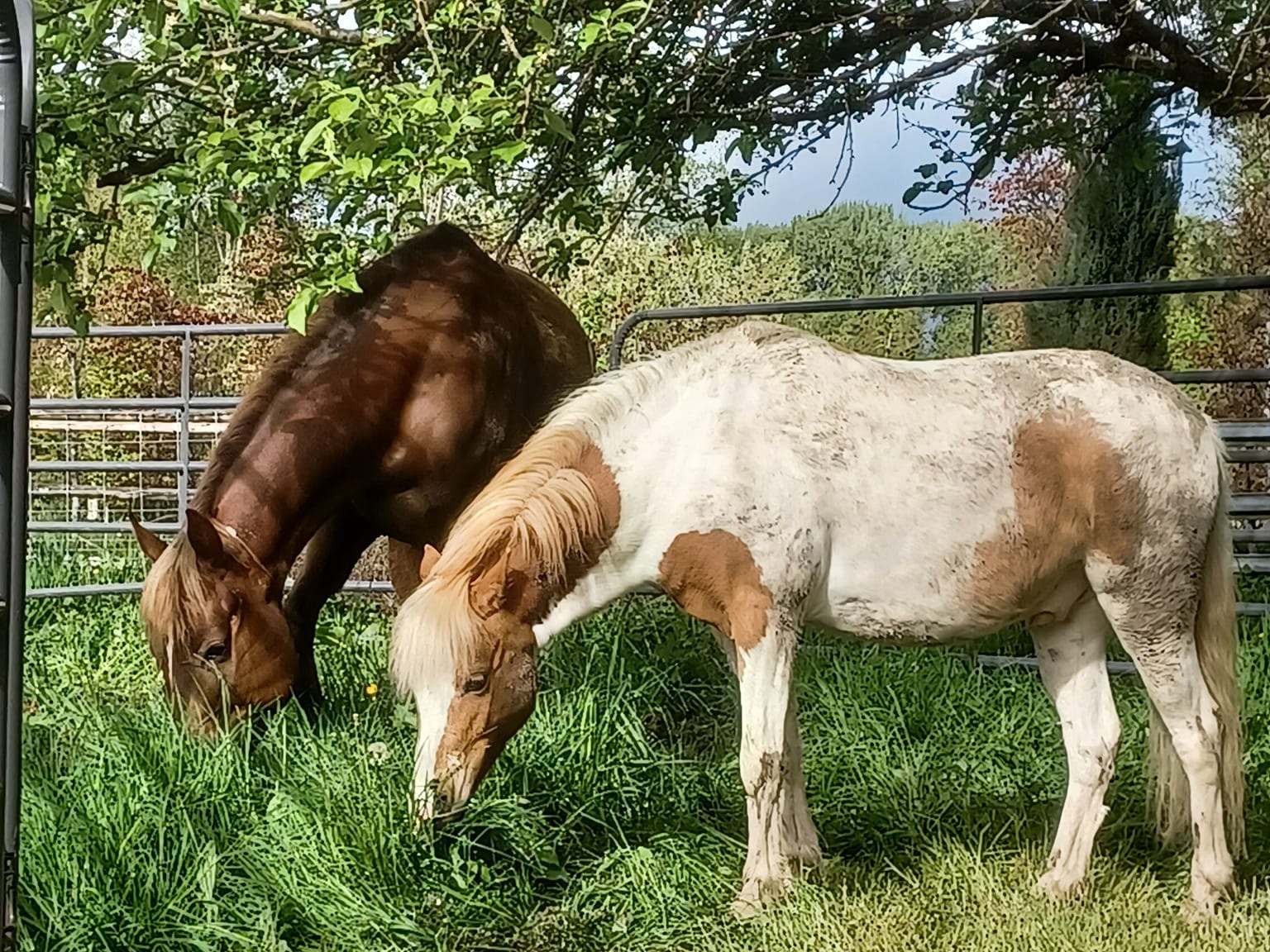
Inula and Finn (Doolin), Foster Friends!
Inula is having the time of her life at her summer foster home, and has been smoothly introduced to foster brother (and alumni!) Finn. The two of them are getting along swimmingly, and it’s clear that where she is, love and grass abound. Inula is one lucky girl!
Even though she is at foster, Inula is still available for adoption. This little sweetie is really showcasing how good of a pasture ornament she will make some lucky person.
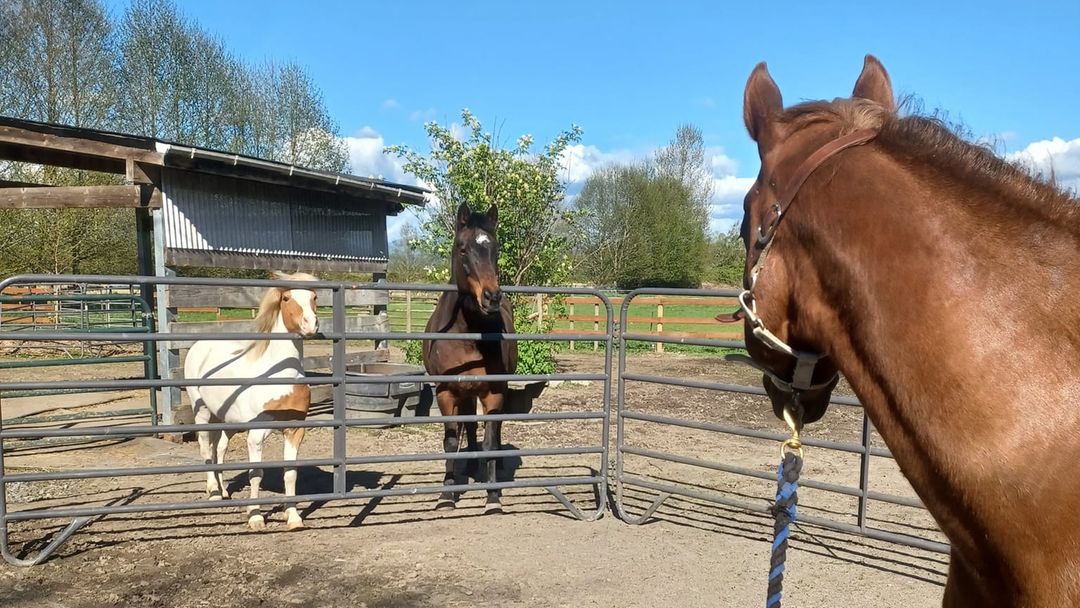
Inula at Foster
For the most part, once a horse comes to SAFE, they will stay on property until they make their way to their forever home. But on rare occasions, a circumstance arises that is too perfect for us to pass up. When an alumni adopter reached out to us expressing her interest in bringing a horse to foster, we could hardly say no. Her pasture acreage would be any horse’s dream summer residence, so the hard part would be choosing a horse. The vast majority of the horses at SAFE are active participants in our horsemanship program, working on going under saddle or becoming more gentle on the ground. Others are in the midst of their rehabbing, or otherwise require a more intensive feed or medication schedule.
Inula, because of her ringbone diagnosis, would not be a riding horse. And while she was learning and providing education on the ground, she is gentle enough to not require intensive work. She is also young — only just five. In short, she was a good choice to send to summer vacation.
So this week, Inula packed her bag (or we packed it for her, seeing as she lacks thumbs) and headed to her summer home a couple miles north. She loaded right up into the trailer, and was quiet on the ride over. Her foster mom took her for an introductory walk around her new home, and her new roommates were very curious about her, as was she about them. They will take their time getting acquainted through the panels first, and will eventually go out together. We are so happy for Inula to have the opportunity to summer somewhere with beautiful grass, and a wonderful foster mom to take care of her!
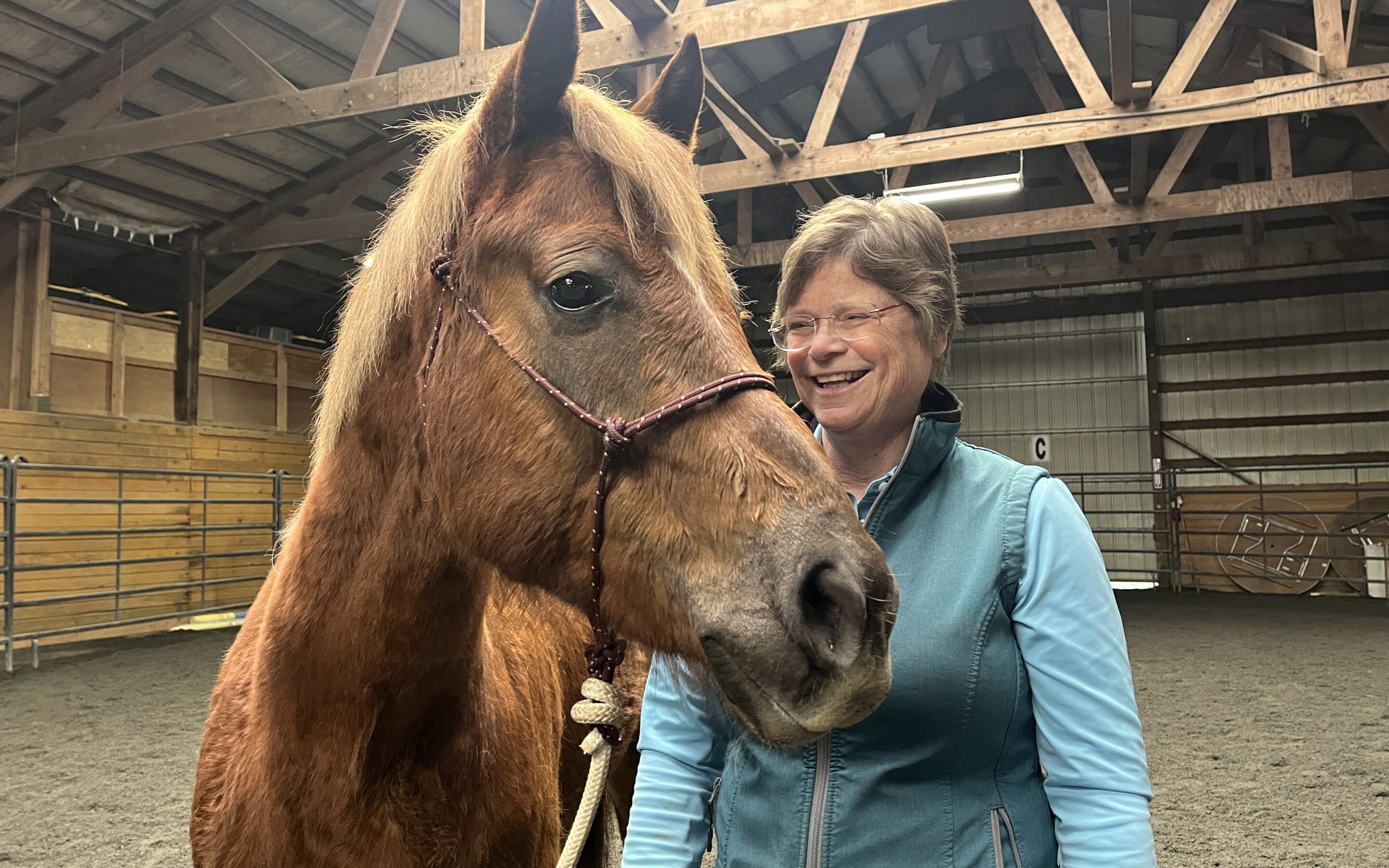
Inula, Teacher and Student
Inula’s ringbone will keep her from being a riding horse, but it doesn’t mean that she can’t develop and hone her skills on the ground. While she is still young and relatively new to everything, Inula has been a fast learner.
Our first impressions of Inula, when she was still sloughing off an unhealthy and smelly coat from her previous home, getting halter started under a warm May sun, were that she was a ‘nice horse.’ Personality wise, yes — she was sweet and curious and lacked some of the world-weariness of her peers, but mostly ‘nice’ as it related to her willingness to learn. She was, or rather is, the type to ask questions, to hunt for answers instead of assuming she already has them, to Try with a capital T. We get many unstarted, unhaltered horses here at SAFE, but rare are those who arrive as relatively blank slates with an open-mind.
Since last May, Inula has continued her work on the ground, learning how to free up her feet and how to hone her feel of people. She is a young horse, and has some ‘baby brain’ moments, but for the most part is a sweet, curious little thing and a real pleasure to spend time around. She has also reached a point in her education where she can begin to be the ‘teacher’ as well as the student. While her groundwork still needs direction (what horse’s doesn’t), she is familiar enough with the movements that she can be used to help educate people who are sharpening their groundwork skills. Her feel‑y nature makes working with her a fun experience, and as a companion, the more people interact with her, the more gentle she will ultimately be.
Horsemanship volunteers Casey and Carrie spent some time with Inula recently, and remarked on how soft (and fun!) she is to spend time with. She really looks for the right answers, and doesn’t take much convincing to move her hind a little bit more, or bring her front a little more intentionally. In layman’s terms, she is a pleasure to have in class, and who can resist petting that lovable face?
Following her working sessions, Inula always stands like a champ for grooming. She is shedding out currently, and offloads what feels like a ton of hair each day! For a little mare who was once incredibly herdbound, she has grown quite comfortable in her solitude, especially when supported by a human.
From not being halter-broke less than a year ago, Inula certainly has come far. This little lady is ready to hindquarters-frontquarters her way into your home and heart!
- Casey works with Inula
- Carrie’s turn
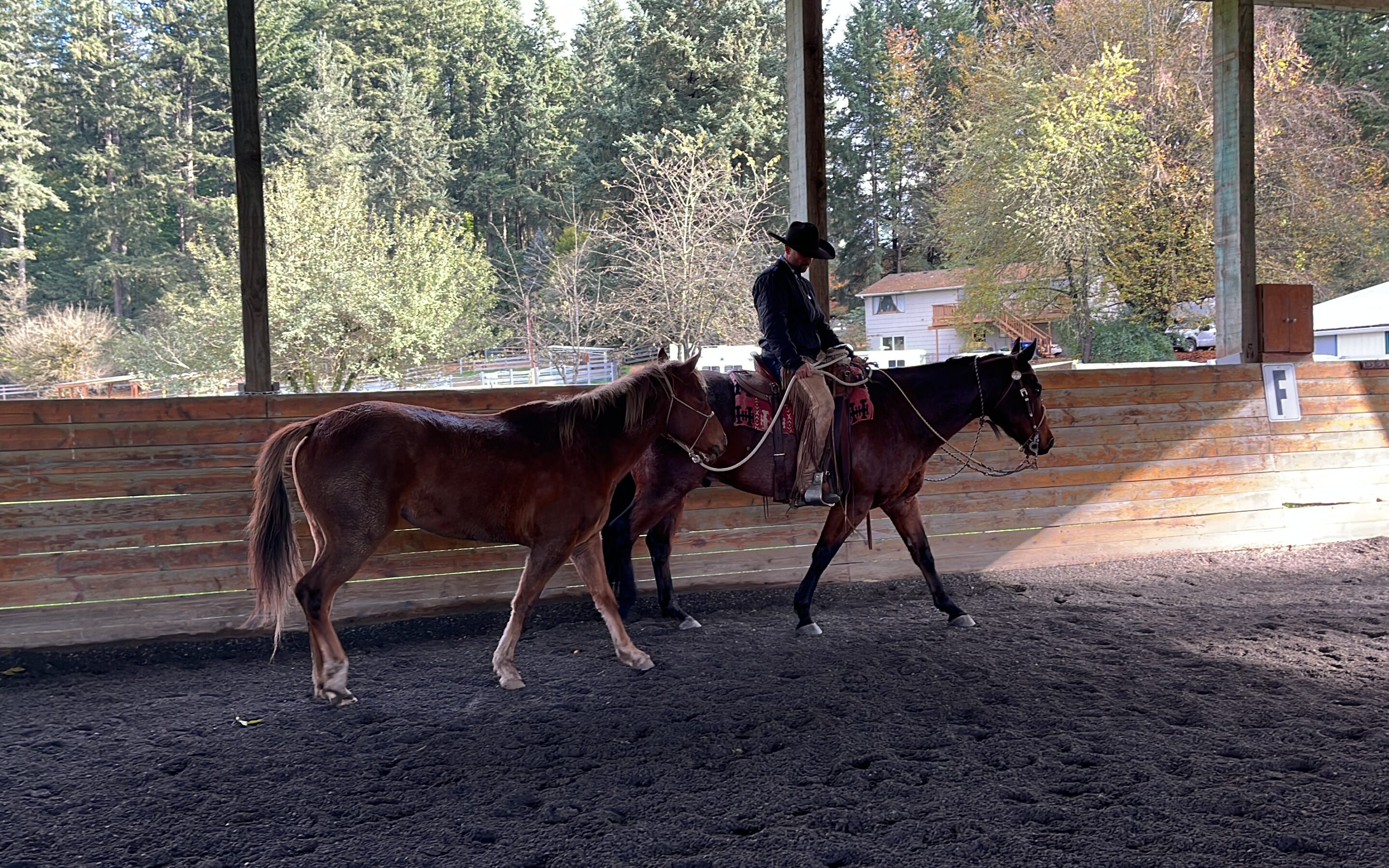
Inula Learns to Pony
Just because you can’t (or shouldn’t) ride a horse doesn’t mean there isn’t a host of fun activities you can get up to with them! The basics are obvious — extended grooming sessions, hand walking and grazing, and the tried and true classic for any and all horse lovers: simply hanging out. But what about more advanced maneuvers? Riding a horse while also leading a horse, called ‘ponying,’ achieves the goal of not only getting two horses out at once, but also provides a new task for you and your riding horse to learn. But there are, as in most horse activities, multiple boxes that need checking before you’re ready to hit the trails with your two(!) equine friends. Obviously, learning how to pony safely is paramount to everyone’s success, but one of the other things you must ensure is that your ponied horse is up to the task. Making sure that they give to pressure is a big part of that. If the line goes taut on a horse with a pullback spot, there is a big chance you could get in a wreck, and potentially injure one or more of your party. That is why preparation is key.
Not every horse will be a perfect pony candidate, which is the nature of life, but we can say with a great deal of confidence that little Inula might be on her way to claiming that title. Last time Joel was here, he and his horse Shoedog, helped to show Inula the ropes, as it were. We had taught Inula how to tie already, after making sure she understood the fundamentals of giving to pressure, and because she had been doing so well with that, cleared her to try ponying. Joel and his mount are wonderful and experienced teachers, so we knew that Inula was in great hands, and that they would be able to help her if the situation went south, but we weren’t particularly worried. And rightly so — sweet Inula had no problem being led alongside Shoedog. Even when Joel asked for a trot, Inula was quick to understand, coming off the pressure as to not take the slack out of the lead. She enjoyed pets from the saddle, and took the whole process in — very cute — stride.
Even though Inula will not be a riding horse, that does not mean we do not teach her skills she can use to be successful on the ground. Learning to pony is a perfect example of this. Who knows, you might see this little cutie trotting alongside a buddy on the trails one day soon!
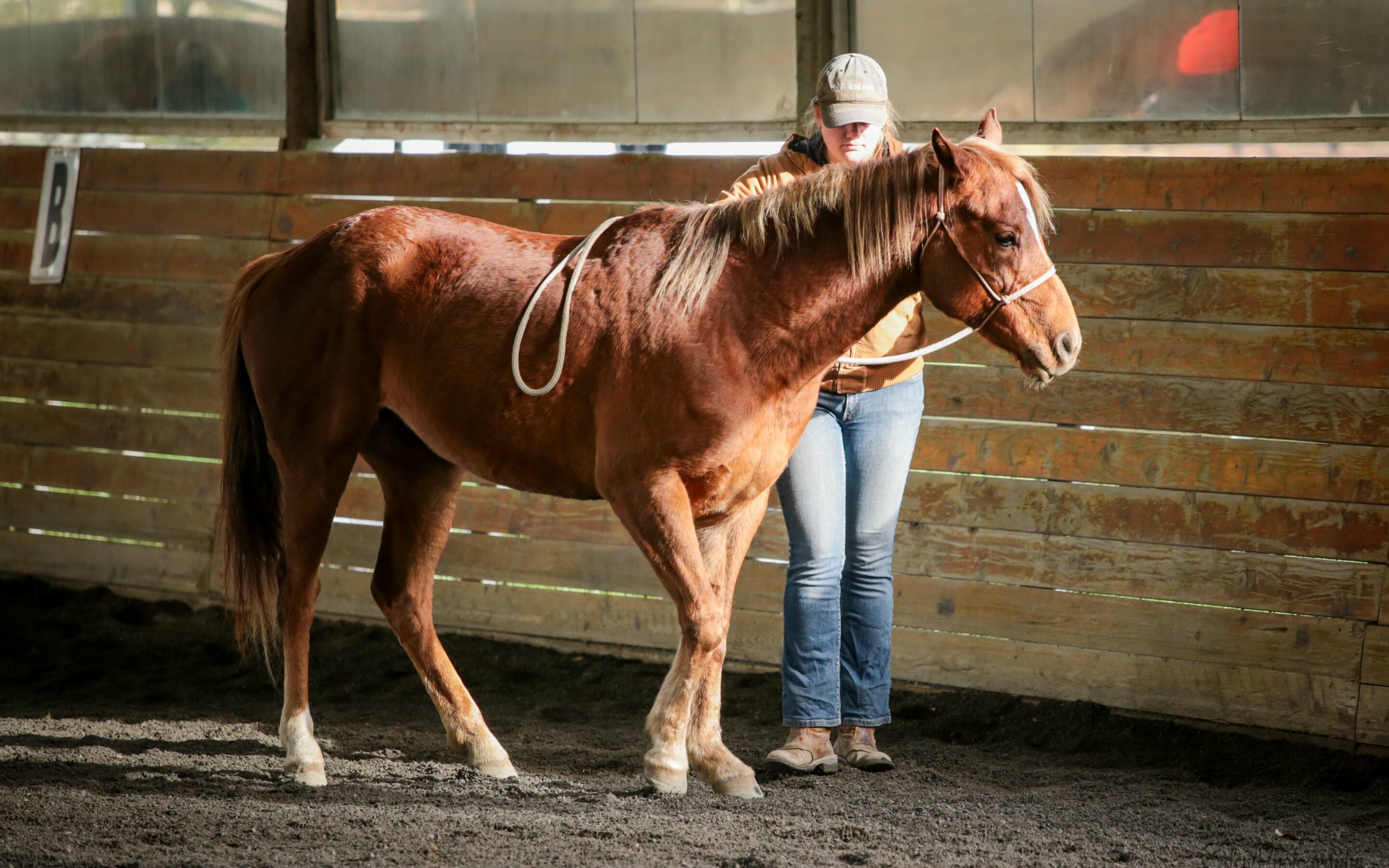
November Clinic Report: Inula
Inula is the type of horse you want to take home to mom, especially if mom is slightly afraid of horses. She has a sweetness about her that’s unmatched by most, a real gentleness that radiates out from her in a little horsey aura. Not to say that there isn’t always the possibility of getting hurt around a 1,000 pound creature (or in her case, closer to 750), but if I had to put my trust in a horse in terms of safety, Inula would be high up on my list.
It’s difficult to believe that back in May, we had to rope Inula to get our hands on her. She acts, for the most part, like she has been domestic all her life. I have been working a bit with Inula over the past few weeks, helping her through the troubled spots she does have (she has a tough time being away from her friends, and can get a little baby-ish about having her feet picked up), and was lucky enough to be able to work her in the recent Joel Conner clinic.
Inula is a quick study, and has a lot of try. It was my struggle over the weekend to try and determine when I should ask more of her, and when I should release her for the effort she was making. She is relatively new at all of this, so the boundaries in which she operates are not quite as narrow as some of the other horses who are more educated. She has an easier time on her right, likely because she has been less handled on that eye, and she was more willing to bend and really reach under herself in hindquarters on that side. But by the end of the weekend she had softened considerably in both directions, and was able to come to a stop with a bend much more readily than she ever had before. We also made great progress with backing up – Inula started out struggling to really get back, and would often encroach on your space when asking her to back up. Over the three days, she started to really gain a better understanding of what was being asked. You always hope that, when working a horse, you leave them at a point where they pick up where you left them, or at least closer to that point than where they began the previous session. Inula definitely picked up each day with more knowledge, and at the end of the weekend had made some great changes! I adore this sweet little mare, and am happy that we were able to spend this time together over the clinic weekend!
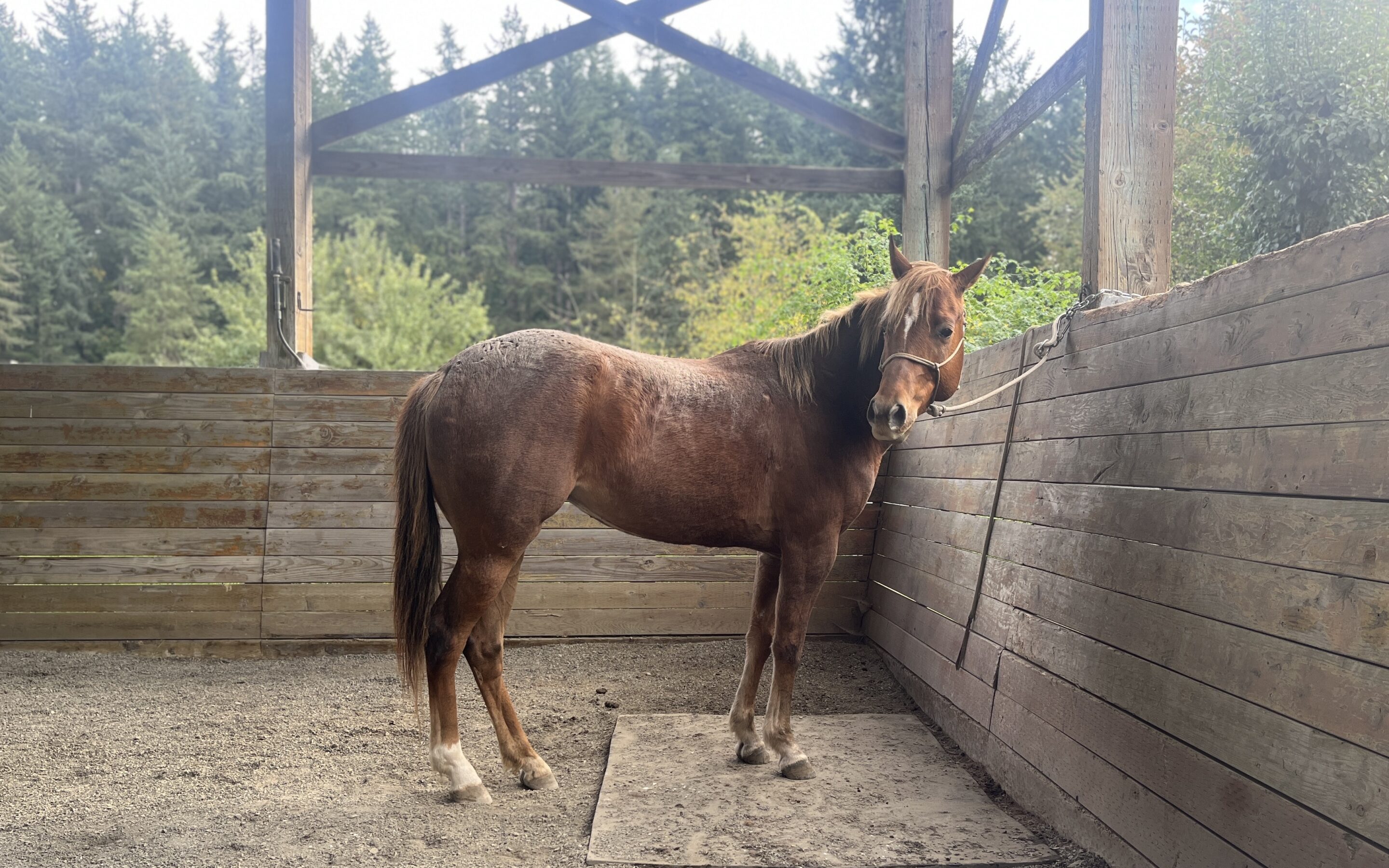
Independent Inula
A few months back, we split up the Gig Harbor horses around the property — integrating them into herds, or otherwise facilitating a change of scenery from the paddock they’d been quarantining and living in up until that point. Mother and daughter, Ciara and Inula, were both involved in this separation, and at the time we had prepared ourselves to deal with the fallout of separating a pair who had likely never been apart. However, Ciara’s reaction told us she really didn’t mind the idea of being an empty nester, and Inula, who was integrated into one of our larger mare herds, hardly batted an eye. Like a kid going off to college and meeting their cool new roommates, Inula found fast comfort in a new home without her mom to cramp her style.
It was a definite relief that the days following their separation were not marked by frantic cross-property calling, as we have experienced before. It seemed Inula was not the type to keep Ciara’s number on speed dial. She was adjusting well to her new herd, and finding herself comfortable enough for her sprawled out nap times amongst her new friends.
However, while we had tested whether or not Inula could be away from Ciara, we had not yet seen Inula on her own.
Here’s the thing about Inula — she is a sweet, kind horse, the type of horse you introduce to someone who is afraid of horses. Despite not having had much handling before arriving at SAFE, she was a quick study, lacking many trouble spots that so many horses who come through our program possess. Apart from the little quirks that come naturally to a young horse, she treated seeing the vet and the farrier like she was a seasoned (albeit lightly) pro, met the hose for a bath without issue, allowed for a rainsheet to be tossed on her as though she’d worn one all her life, and generally speaking kept a tremendously level head throughout mostly all new experiences. But the one thing that Inula had difficulty with, her Achilles heelbulb, was being alone.
With a friend around, all the above things were true. Inula was a wunderkind, cute and sweet and wise beyond her years. On her own, however, it became clear how much trouble Inula had finding comfort in anything but another horse. Horses are herd animals, not meant to be solitary. But there are times in life that call for moments of separation. If a horse does not learn how to find some manner of peace in being alone for periods of time, things become risky. Herdbound horses run themselves through fences, or work themselves up into such a state that they colic. These are worst-case scenarios, but it does not make them any less possible.
In Inula’s case, we’ve spent hours over the last few weeks helping her learn to be okay away from her friends. We pull her out of her paddock or her stall and bring her to hang out in the arena for a little while, speedrunning the same separation we achieve by splitting horses into paddocks, but still allowing Inula turnout with her buddies. It was also a great opportunity to teach her how to stand tied. A real win-win.
Inula did not think the same at first. She put up quite an ear-splitting fuss at having to spend time away from her buddies, and whenever a horse who was previously unknown to her would enter or leave the arena, she would hoot and holler like her life depended on it. While she was learning to tie, we would flag her back and forth along the wall to show her what her range of motion was and encourage her to move laterally versus pulling pack, and when she grew especially agitated at the absence of a horse she felt was supporting her, we would change her mind to thoughts of other things by moving her along the wall. But for the most part, we just hung out alongside her, showing her that apart from some mild frustration, nothing bad would happen to her were she to be left alone.
When she was quiet and calm, we would pay her lots of attention, brushing her coat or giving her a scratch. Those very first days, the quiet moments were few and far between, and so as soon as one of them lasted longer than a few moments, we took the opportunity to take her back to her buddies, rewarding her for her patience.
Over the days, these periods of peace got longer and longer, until Inula could stand for an hour or two in (mostly) quiet, napping with her head against the wall of the arena. It is actually what she is doing right now, as I write this article. Tremendous changes!
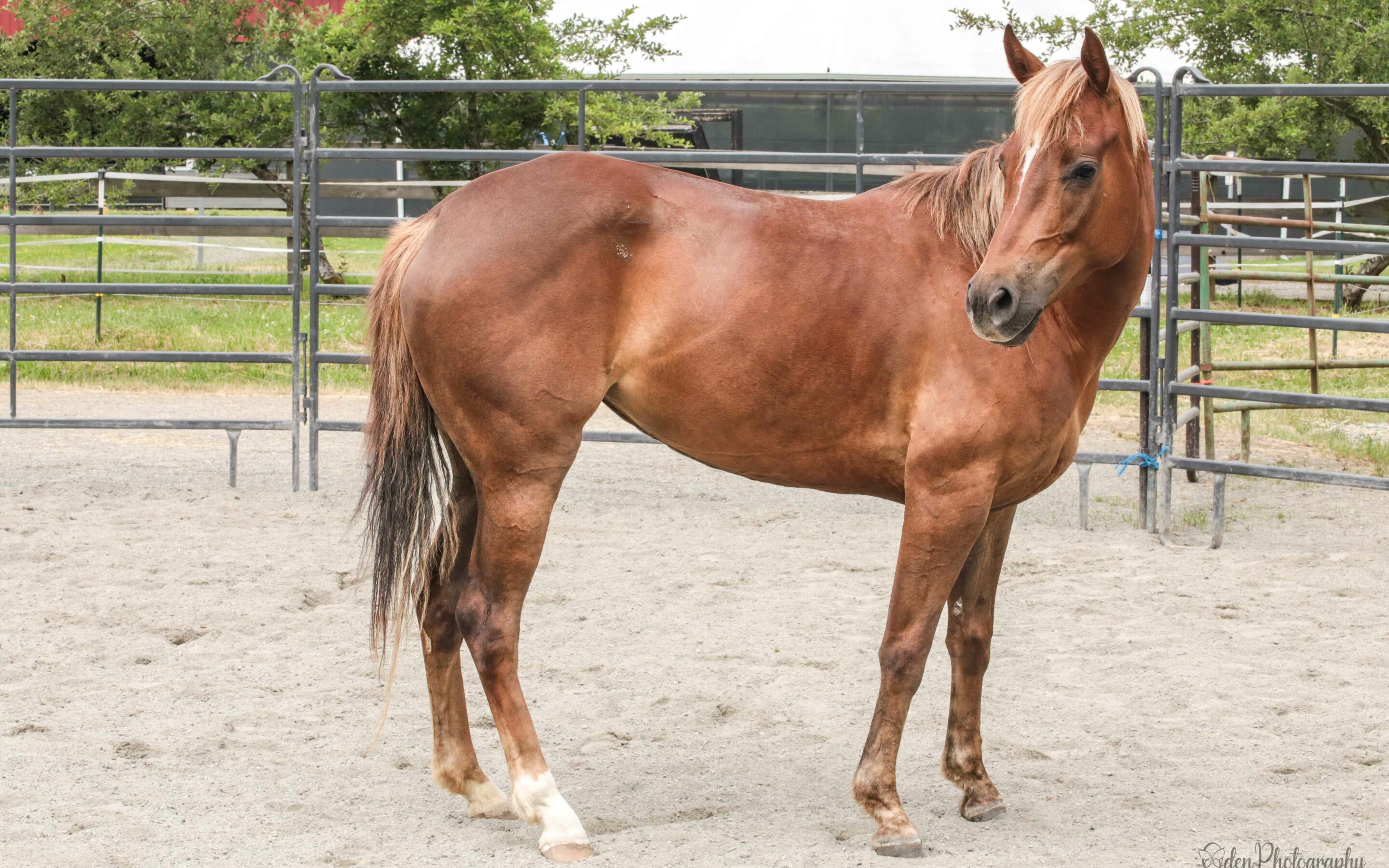
Introducing Inula
Inula was the youngest of the Gig Harbor horses, and despite not being a literal baby, she still had a youthful element about her that we made note of from our first meeting. A subsequent dental put her in her 4th year this year, but when you compare her to a horse like Addie, who was newly 5 when she came under our care, Inula felt so much younger. I don’t mean to make this out to be a bad thing — her youth just meant she hadn’t had a lot of experiences of any kind, and it was clear that she was very open to exploring the world with her whole heart open to it.
She and her mother, Ciara, were kept separate from the rest of the mare herd on the property from which they came. They both wore ratty coats that we couldn’t wait to get our hands on, knowing the lackluster tufts of hair that hung off their bodies would come away easily under a brush. They also stank, but a different smell altogether from just ‘dirty horse’ (which, in the right circles, might do well on the fragrance market). They smelled, as someone remarked from a good distance away, like death.
But it was just a product of their environment, and nothing to do with them internally. Unloading off the trailer onto the first solid ground they’d felt in who knows how long, they were curious and sweet — mostly baby Inula, who stayed close to mom while still making her own explorations of the world. Their feet were long, cracked and slipper-toed, and while we had a bit to do before they’d be ready for the professional rasp, we knew that the gravel they now called home would do a good deal in helping the mares self trim.
Those first few days in the round pen, we worked on getting a routine down to separate Inula from her mom, and vice versa. Our solution came as running them both into the pen, and then herding one out to sit and eat alfalfa in the attached chute. All of the horses were quite herd bound to one another, Inula and Ciara no exception to this, and in the interest of working on one thing at a time, we kept them within close range during those initial days.
Inula’s lack of handling came across to us immediately, but perhaps not in the way you might thing. True, she didn’t have a great understanding of what pressure meant at first, and was naturally a little wigged out by things touching her, but her foundation was built on a willingness to try. You could almost see the little gears working away in her head as she puzzled out what was being asked of her, and how she could achieve it. Because of prior handling, many horses come to us feeling like they already know the answer to the question they are being asked, but in Inula’s case, she was the one asking the questions.
She is also just tremendously sweet. She has within her an inherent kindness, an energy that radiates out from her and is easy to feel, I’d argue, even for non-horse people. As someone who loves all horses, it likely doesn’t sound like much coming from me, but Inula is one of the nicest horses to simply be around. She is truly a pleasure to have in class.
During her time at SAFE, she has hit many milestones, including having her teeth floated (she was a very brave little lady, walking into the barn, and standing as a nice support beside her mother while she went under the drill), getting her necessary vaccines (hardly blinking at the needle), having her feet trimmed twice (where she stood like a total pro), and separating from Ciara to join another herd (more on that particular story later). Even as the darker months loom, Inula’s future remains bright.
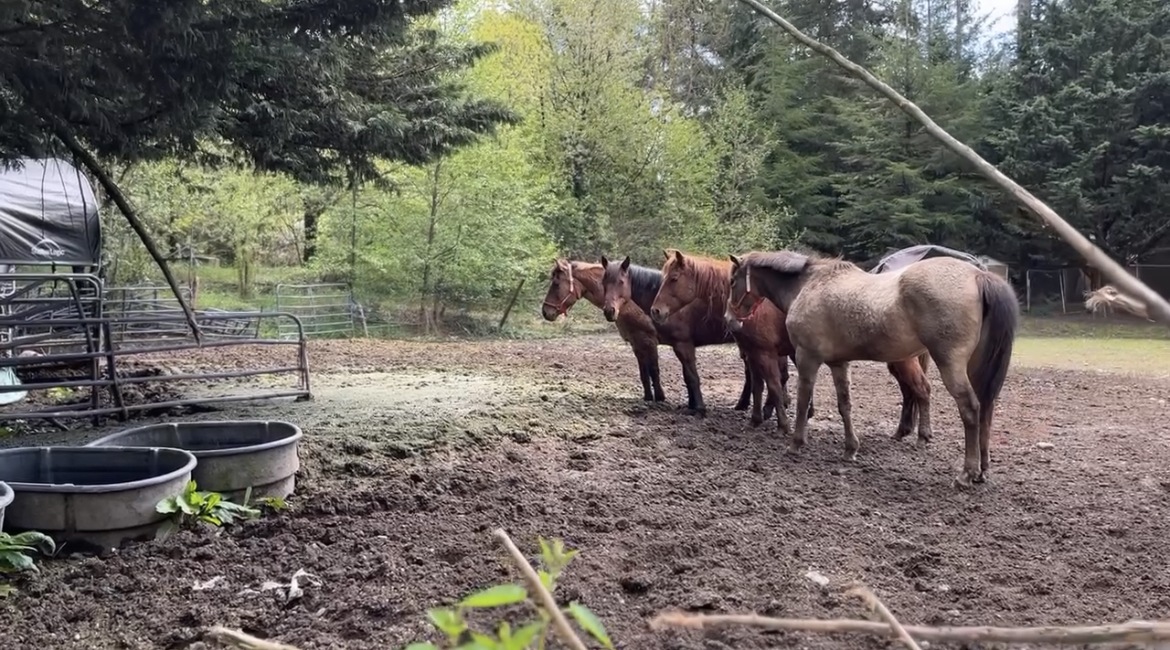
Introducing the Gig Harbor 7
The majority of the horses who come to SAFE come as singles or in pairs. One here, one there, typically with some space in between arrivals. But on occasion, we are called to assist with a larger seizure. It hasn’t been all that long since the Fall City 40, and an even shorter period since we took in the Graham 27. Now, we were once again called to help with a multi-horse intake. Seven horses in the Gig Harbor area needed our help, the owner needing to quickly re-home horses that were not easily re-homeable. On the heels of the Graham horses, we felt a bit more prepared for a larger intake, but unlike the Graham horses, these horses had not had regular (or any) handling in some time.
So on a Saturday morning, we loaded up our trailers with panels, and set out with a robust team of people and a brigade of trailers and a plan to pull seven horses out of the mud.
Thanks to a ton of planning, a great deal of manpower, and an earlier scope of the property, we were able to successfully remove all the horses from the property over the course of just a few hours. We ran chutes from the pens, some quite winding and intricate, but everyone left unscathed, and arrived at SAFE in one piece.
Lancelot, the stallion, was the first to pull through the gates.
Next were mother and daughter, Ciara and Inula,
followed by the small herd of mares: Meadow and Mirana, the elders of the group, (and the only ones who allowed us to halter them), and Wren and Harissa.
Seeing them at SAFE was like seeing them with the lights clicked on for the first time. It was clear they were in need of some TLC, but out of the mud and muck, it became obvious just how much. Their feet were overgrown, slippered in some cases. The four mares had a line of what appeared to be rotten hair halfway up their legs, likely a result of standing in a high layer of wet ground. The mother and daughter stank, a smell like rotting, and while there was nothing visibly deceased on the property, it felt very much like a place where death lived. All of them, when confronted with clean water troughs, drank long and deep.
It was clear from the moment we set eyes on the horses that they would take some work to rehab and retrain. Even the mares who let us halter them were not keen on being touched much beyond that. We certainly had our work cut out for us. But this was not the first time that challenging horses had come through our gates, and it will not be the last. The road ahead might be long, but the most important thing is that these horses are safe now, and that is all that matters.
Inula’s Friends:
1. Whitney-Bear B.
2. Susan C.
3. ____________________
4. ____________________
5. ____________________
6. ____________________
7. ____________________
8. ____________________
9. ____________________
10._____________________
Every horse deserves at least ten friends! Even a small monthly donation can make a difference. Plus, SAFE horse sponsors receive discounts at local businesses through the SAFEkeepers program!


